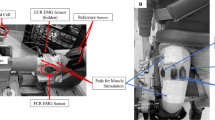Abstract
Synaptic efficacy associated with muscle spindle feedback is regulated via depression at the Ia-motoneurone synapse. The inhibitory effects of repetitive Ia afferent discharge on target motoneurones of different sizes were investigated during a passive stretch of ankle extensors in humans. H-reflex recruitment curves were collected from the soleus muscle for two conditions in ten subjects. H-reflexes were elicited during passive stretch at latencies of 50, 100, 300, and 500 ms after a slow (20°/s) dorsiflexion about the right ankle (from 100 to 90°). Control H-reflexes were recorded at corresponding static (without movement) ankle angles of 99, 98, 94, and 90° of flexion. The slope of the H-reflex recruitment curves (Hslp) was then calculated for both conditions. H-reflex values were similar for the static and passive stretch conditions prior to 50–100 ms, not showing the early facilitation typical of increased muscle spindle discharge rates. However, the H-reflex was significantly depressed by 300 ms and persisted through 500 ms. Furthermore, less than 300 ms into the stretch, there was significantly greater H-reflex depression with a lower stimulus intensity (20 % Mmax) versus a higher stimulus intensity (Hmax), though the effects begin to converge at later latencies (>300 ms). This suggests there is a distinct two-stage temporal process in the depression observed in the Ia afferent pathway for all motoneurones during a passive stretch. Additionally, there is not a single mechanism responsible for the depression, but rather both heterosynaptic presynaptic inhibition and homosynaptic post-activation depression are independently influencing the Ia-motoneurone pathway temporally during movement.




Similar content being viewed by others
References
Brown MC, Matthews PB (1960) The effect on a muscle twitch of the back-response of its motor nerve fibres. J Physiol 150:332–346
Cheng J, Brooke JD, Misiaszek JE, Staines WR (1995) The relationship between the kinematics of passive movement, the stretch of extensor muscles of the leg and the change induced in the gain of the soleus H reflex in humans. Brain Res 672:89–96
Crone C, Nielsen J (1989) Methodological implications of the post activation depression of the soleus H-reflex in man. Exp Brain Res 78:28–32
Eccles JC, Rall W (1951) Effects induced in a monosynaptic reflex path by its activation. J Neurophysiol 14:353–376
Hilgevoord AA, Koelman JH, Bour LJ, Ongerboer V (1994) Normalization of soleus H-reflex recruitment curves in controls and a population of spastic patients. Electroencephalogr Clin Neurophysiol 93:202–208
Houk JC, Rymer WZ, Crago PE (1981) Dependence of dynamic response of spindle receptors on muscle length and velocity. J Neurophysiol 46:143–166
Hugon M (1973) Methodology of the Hoffmann reflex in man. In: Desmedt JE (ed) New developments in electromyography and clinical neurophysiology. Karger, Basel, pp 277–293
Hultborn H, Nielsen JB (1998) Modulation of transmitter release from Ia afferents by their preceding activity—a “postactivation depression”. In: Rudomin P, Romo R, Mendell LM (eds) Presynaptic inhibition and neural control. Oxford University Press, New York, pp 178–191
Hultborn H, Illert M, Nielsen J, Paul A, Ballegaard M, Wiese H (1996) On the mechanism of the post-activation depression of the H-reflex in human subjects. Exp Brain Res 108:450–462
Kohn AF, Floeter MK, Hallett M (1997) Presynaptic inhibition compared with homosynaptic depression as an explanation for soleus H-reflex depression in humans. Exp Brain Res 116:375–380
Lloyd DPC, Wilson VJ (1957) Reflex depression in rhythmically active monosynaptic reflex pathways. J Gen Physiol 40:409–426
Misiaszek JE, Brooke JD, Lafferty KB, Cheng J, Staines WR (1995) Long-lasting inhibition of the human soleus H reflex pathway after passive movement. Brain Res 677:69–81
Morita H, Petersen N, Christensen LO, Sinkjaer T, Nielsen J (1998) Sensitivity of H-reflexes and stretch reflexes to presynaptic inhibition in humans. J Neurophysiol 80:610–620
Nielsen J, Petersen N, Crone C (1995) Changes in transmission across synapses of Ia afferents in spastic patients. Brain 118(Pt 4):995–1004
Pinniger GJ, Nordlund M, Steele JR, Cresswell AG (2001) H-reflex modulation during passive lengthening and shortening of the human triceps surae. J Physiol 534:913–923
Proske U, Morgan DL, Gregory JE (1993) Thixotropy in skeletal muscle and in muscle spindles: a review. Prog Neurobiol 41:705–721
Robertson CT, Koceja DM (2003) Post-activation depression of the soleus H-reflex in the elderly. Electromyogr Clin Neurophysiol 43:103–111
Roll JP, Vedel JP (1982) Kinaesthetic role of muscle afferents in man, studied by tendon vibration and microneurography. Exp Brain Res 47:177–190
Rudomin P, Schmidt RF (1999) Presynaptic inhibition in the vertebrate spinal cord revisited. Exp Brain Res 129:1–37
Trimble MH, Du P, Brunt D, Thompson FJ (2000) Modulation of triceps surae H-reflexes as a function of the reflex activation history during standing and stepping. Brain Res 858:274–283
Voigt M, Sinkjaer T (1998) The H-reflex in the passive human soleus muscle is modulated faster than predicted from post-activation depression. Brain Res 783:332–346
Wood SA, Gregory JE, Proske U (1996) The influence of muscle spindle discharge on the human H reflex and the monosynaptic reflex in the cat. J Physiol 497(Pt 1):279–290
Zucker RS, Regehr WG (2002) Short-term synaptic plasticity. Annu Rev Physiol 64:355–405
Author information
Authors and Affiliations
Corresponding author
Rights and permissions
About this article
Cite this article
Robertson, C.T., Kitano, K., Koceja, D.M. et al. Temporal depression of the soleus H-reflex during passive stretch. Exp Brain Res 219, 217–225 (2012). https://doi.org/10.1007/s00221-012-3080-1
Received:
Accepted:
Published:
Issue Date:
DOI: https://doi.org/10.1007/s00221-012-3080-1




